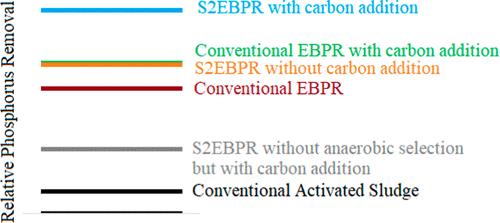Improving Enhanced Biological Phosphorus Removal with Return Activated Sludge Fermentation and Carbon Addition in a Benchtop Sequencing Batch Reactor Treating Real Wastewater
引用次数: 0
Abstract
Enhanced biological phosphorus (P) removal (EBPR) with return activated sludge (RAS) fermentation (S2EBPR) is a recent EBPR innovation suggested to achieve more stable and efficient P removal. However, consensus around these benefits and the mechanisms of S2EBPR is still developing. To further this understanding, three pilot sequencing batch reactors treating real domestic wastewater were operated as S2EBPR or conventional EBPR, with or without external carbon addition, and as S2EBPR with or without the anaerobic phase. Findings include the following: (1) S2EBPR showed a small P removal improvement over conventional EBPR; (2) S2EBPR performed substantially better with a small dose of external carbon added, while conventional EBPR did not, but microbial community stability was increased in both; (3) when external carbon to S2EBPR was stopped, high P removal continued for two solids retention times; (4) the measured fermentation yield suggested a larger benefit to S2EBPR P removal than was observed; (5) S2EBPR without the anaerobic phase did not achieve good P removal; and (6) although microbial community trends were similar, S2EBPR enriched more metabolically flexible polyphosphate accumulating organisms than conventional EBPR, importantly, Candidatus Phosphoribacter. Overall, RAS fermentation was beneficial to EBPR performance and stability with external carbon addition but minimally without.

在处理实际废水的台式序批式反应器中利用回流活性污泥发酵和碳添加改进强化生物除磷技术
利用回流活性污泥(RAS)发酵强化生物除磷(EBPR)(S2EBPR)是最近提出的一项 EBPR 创新,可实现更稳定、更高效的除磷效果。然而,围绕这些优势和 S2EBPR 机制的共识仍在发展中。为了进一步加深理解,三个处理实际生活污水的中试序批式反应器分别作为 S2EBPR 或传统 EBPR、有无外部碳添加以及有无厌氧阶段的 S2EBPR 运行。研究结果如下(1) 与传统的 EBPR 相比,S2EBPR 对 P 的去除率略有提高;(2) S2EBPR 在添加小剂量外部碳的情况下性能大大提高,而传统的 EBPR 则没有,但两者的微生物群落稳定性都有所提高;(3) 当停止向 S2EBPR 添加外部碳时,在两个固体停留时间内仍能保持较高的 P 去除率;(4) 测量的发酵产量表明,S2EBPR 的除磷效果比观察到的要好;(5) 没有厌氧阶段的 S2EBPR 没有达到很好的除磷效果;(6) 虽然微生物群落趋势相似,但与传统 EBPR 相比,S2EBPR 富集了更多代谢灵活的聚磷酸盐积累生物,其中重要的是磷细菌。总之,在添加外部碳的情况下,RAS 发酵有利于 EBPR 的性能和稳定性,但在不添加外部碳的情况下,其效果甚微。
本文章由计算机程序翻译,如有差异,请以英文原文为准。
求助全文
约1分钟内获得全文
求助全文

 求助内容:
求助内容: 应助结果提醒方式:
应助结果提醒方式:


